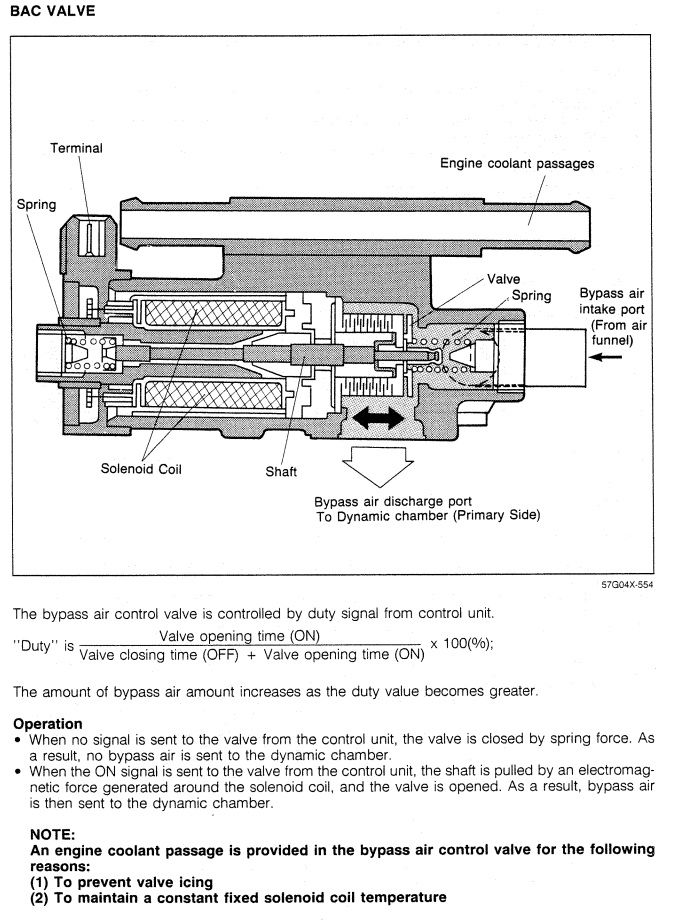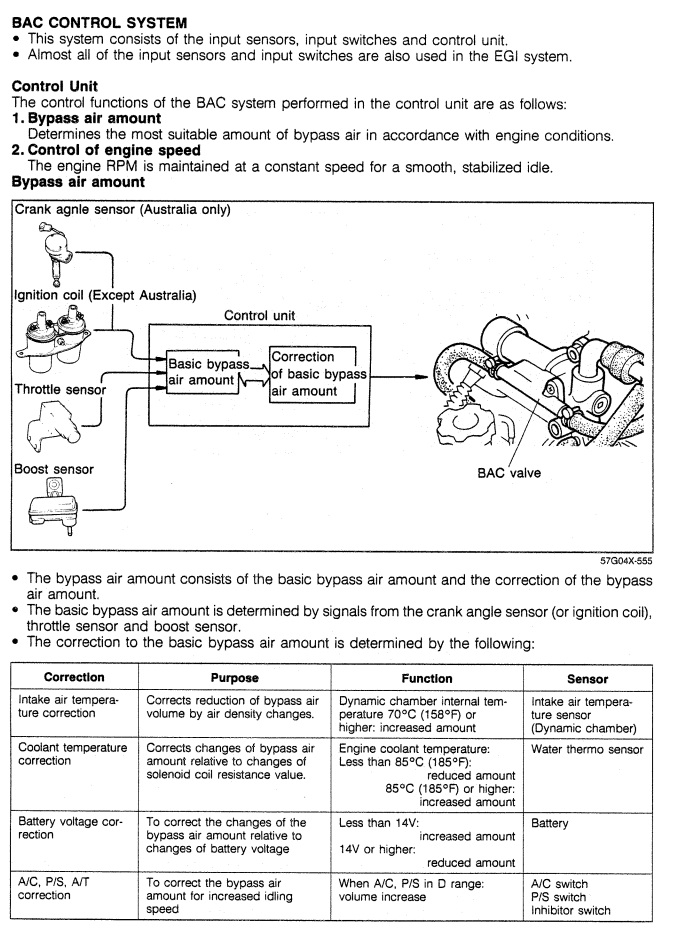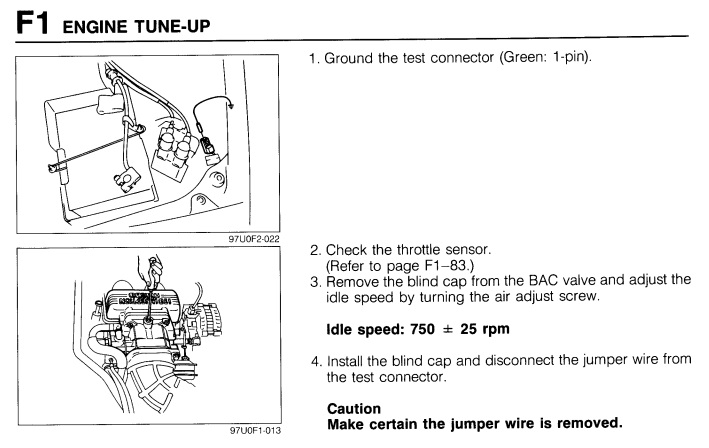BAC and High Idle Trouble
#1
I touch my Wankel.
Thread Starter
iTrader: (1)
Join Date: Aug 2007
Location: Muskegon, MI
Posts: 273
Likes: 0
Received 0 Likes
on
0 Posts
BAC and High Idle Trouble
To start off, I have done a lot of research and testing to try and track down this problem. The engine I am dealing with is a streetported S5 that has been transplanted into an FB.
From the first start, it has had idle trouble, most of which seems to be originating from the BAC. It starts easily with the first turn of the key hot and cold. If cold, it idles ~1500rpm and when it gets warm, the idle drops to ~1100. At this point the only thing holding the idle so high is the BAC. Pinching the hose kills the engine instantly. Unplugging the BAC yields the same result, so it cannot be stuck open. I have not yet tried replacing the BAC, but am looking for a replacement. All thermowax and fast idle cam stuff has been removed from the throttle body.
Investigating farther, I checked the Vref and water thermosensor. At the pressure sensor, the Vref at idle reads 4.5v. At the water thermosensor, I read 2v when cold and 0.5 v when hot. Is this too far out of spec? I need to backprobe it at the ECU to see what value it is actually getting.
It has also thrown the CEL code #02 - CAS Ne signal. According to the FSM, the engine should not be able to run with this code thrown, but it does. I have replaced the CAS and it's shielded wiring and still the code persists. I have also tried replacing the ECU itself.
Can anyone shed any light on this for me? Why is the ECU setting the BAC duty cycle at 100%? What is it about the CAS that could be throwing a false code like that? Should I replace the thermosensor?
From the first start, it has had idle trouble, most of which seems to be originating from the BAC. It starts easily with the first turn of the key hot and cold. If cold, it idles ~1500rpm and when it gets warm, the idle drops to ~1100. At this point the only thing holding the idle so high is the BAC. Pinching the hose kills the engine instantly. Unplugging the BAC yields the same result, so it cannot be stuck open. I have not yet tried replacing the BAC, but am looking for a replacement. All thermowax and fast idle cam stuff has been removed from the throttle body.
Investigating farther, I checked the Vref and water thermosensor. At the pressure sensor, the Vref at idle reads 4.5v. At the water thermosensor, I read 2v when cold and 0.5 v when hot. Is this too far out of spec? I need to backprobe it at the ECU to see what value it is actually getting.
It has also thrown the CEL code #02 - CAS Ne signal. According to the FSM, the engine should not be able to run with this code thrown, but it does. I have replaced the CAS and it's shielded wiring and still the code persists. I have also tried replacing the ECU itself.
Can anyone shed any light on this for me? Why is the ECU setting the BAC duty cycle at 100%? What is it about the CAS that could be throwing a false code like that? Should I replace the thermosensor?
#2
Engine, Not Motor
iTrader: (1)
Join Date: Feb 2001
Location: London, Ontario, Canada
Posts: 29,789
Likes: 0
Received 108 Likes
on
91 Posts
Has the proper mechanical idle adjustment been done? The car should idle without the BAC, though somewhat lower. If it instantly dies, it sounds like the throttle plates are closed.
#3
I touch my Wankel.
Thread Starter
iTrader: (1)
Join Date: Aug 2007
Location: Muskegon, MI
Posts: 273
Likes: 0
Received 0 Likes
on
0 Posts
I've backed off the throttle stop completely to make sure that there is nothing else holding the throttle open. If I use the throttle stop, the idle will be even higher because the BAC is still doing it's thing. I read that the mechanical throttle stop should be set at 0.016". I don't want to just eliminate the BAC because that would just be masking the problem. Should I be able to hold a 750rpm idle using only the mechanical adjustment and BAC unplugged?
#5
I touch my Wankel.
Thread Starter
iTrader: (1)
Join Date: Aug 2007
Location: Muskegon, MI
Posts: 273
Likes: 0
Received 0 Likes
on
0 Posts
Timing is good I have checked and double checked that. Also I don't think the ECU would know if the timing was off, but regardless.
How is the screw on top of the throttle body connected to the BAC? I have checked and rechecked the TPS and set it using the resistance method.
I grounded the ISC when setting the timing, but not while setting the idle. Does the ISC turn off the BAC? I can do that by unplugging it. When I get home I will mechanically set the throttle opening to 0.016" and make sure that the hole in the primary is open. I will ground out the ISC and try to set the idle to 750rpm using the screw on top of the throttle body. By grounding the ISC and then removing the ground do you think the ECU will reset the duty cycle for the BAC to something more reasonable?
Any thoughts on the CAS and CEL issues?
How is the screw on top of the throttle body connected to the BAC? I have checked and rechecked the TPS and set it using the resistance method.
I grounded the ISC when setting the timing, but not while setting the idle. Does the ISC turn off the BAC? I can do that by unplugging it. When I get home I will mechanically set the throttle opening to 0.016" and make sure that the hole in the primary is open. I will ground out the ISC and try to set the idle to 750rpm using the screw on top of the throttle body. By grounding the ISC and then removing the ground do you think the ECU will reset the duty cycle for the BAC to something more reasonable?
Any thoughts on the CAS and CEL issues?
#7
Timing is good I have checked and double checked that. Also I don't think the ECU would know if the timing was off, but regardless.
How is the screw on top of the throttle body connected to the BAC? I have checked and rechecked the TPS and set it using the resistance method.
I grounded the ISC when setting the timing, but not while setting the idle. Does the ISC turn off the BAC? I can do that by unplugging it. When I get home I will mechanically set the throttle opening to 0.016" and make sure that the hole in the primary is open. I will ground out the ISC and try to set the idle to 750rpm using the screw on top of the throttle body. By grounding the ISC and then removing the ground do you think the ECU will reset the duty cycle for the BAC to something more reasonable?
Any thoughts on the CAS and CEL issues?
How is the screw on top of the throttle body connected to the BAC? I have checked and rechecked the TPS and set it using the resistance method.
I grounded the ISC when setting the timing, but not while setting the idle. Does the ISC turn off the BAC? I can do that by unplugging it. When I get home I will mechanically set the throttle opening to 0.016" and make sure that the hole in the primary is open. I will ground out the ISC and try to set the idle to 750rpm using the screw on top of the throttle body. By grounding the ISC and then removing the ground do you think the ECU will reset the duty cycle for the BAC to something more reasonable?
Any thoughts on the CAS and CEL issues?
Trending Topics
#8
Timing is good I have checked and double checked that. Also I don't think the ECU would know if the timing was off, but regardless.
How is the screw on top of the throttle body connected to the BAC? I have checked and rechecked the TPS and set it using the resistance method.
How is the screw on top of the throttle body connected to the BAC? I have checked and rechecked the TPS and set it using the resistance method.
--vacuum leaks if present (not good)
--air passing through the throttle plates (a function of throttle plate adjustment and the fast idle system)
--air bypassing the throttle plates altogether through the air bypass passage way. this is controlled by the screw.
--air passing through the accelerated warmup system solenoid and air supply valve, depending on what model you have
--air passing through the idle air control/bypass air control valve. The bypass air control valve is just a hole with a spring loaded plunger closing it. There is a magnet inside the valve. The EFI circuit supplies +12V to the magnet with the key on. The ECU turns on the ground. When the ECU supplies ground, the magnet engages and pulls open the plunger against the spring force. The ECU cycles the ground rapidly so that the valve pulses open and closed. The ratio of ON to OFF time in a given period is the duty cycle.

The ECU has a feedback system to vary BAC duty cycle according to normal changes in operating conditions.

This system gets confused unless the BAC valve is set to a fixed duty cycle. On the FC, you jumper the initial set coupler. On the FD you jumper a terminal in the diagnostic box. There is nothing unique about the Rx-7 idle control system. It is very similar to what is used on Fords, Hondas, and Nissans of that era for example.
Does the ISC turn off the BAC?

On some cars with this style of idle air control you do in fact turn off the IACV to set the idle. On 90s Hondas for example you are supposed to unplug the IACV, adjust the idle speed to 450rpm, then plug the IACV back in and you will now be at a normal 750-800rpm.
#9
if the throttle plates are open a crack would that not cause a high bouncing idle ...i hthink they should be completly closed on start up , you may have to take it of to see if the plates are closetd propelly...there is a little hole in the primary plates whichcontrols the air
Thread
Thread Starter
Forum
Replies
Last Post
Jeff20B
1st Generation Specific (1979-1985)
73
09-16-18 07:16 PM
[For Sale] Scratch & Dent, Used, and Open-Box Sale!
SakeBomb Garage
Vendor Classifieds
5
08-09-18 05:54 PM




